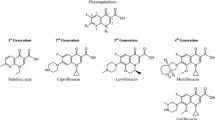Abstract
· Background: Lomefloxacin 0.3% ophthalmic solution twice daily has been compared in patients with bacterial conjunctivitis in six randomized double-blind or investigator-masked phase III studies with either chloramphenicol 0.5% 5×/day, gentamicin 0.3% 4×/day, fusidic acid 1% 2×/day, tobramycin 0.3% 4×/day or norfloxacin 0.3% 4×/day. · Methods: A meta-analysis of all individual data of these six studies was performed. A total of 582 patients with clinically diagnosed bacterial conjunctivitis were evaluated by slit-lamp examination with grading of eight key signs and symptoms and by conjunctival swab cultures at baseline, on day 3–5 and on day 7–9. Success of therapy, local tolerance and safety were evaluated at termination. In vitro sensitivity of the ocular isolates to 6–10 antibiotics was evaluated by disk diffusion tests. · Results: Two hundred and ninety patients treated with lomefloxacin 0.3% (LF) and 292 patients treated by one of the control antibiotics (combined control group, CCG) were enrolled in the studies. Two hundred and seventy-eight LF and 283 CCG patients were evaluable for the intent-to-treat (ITT) analysis, while 85 LF and 95 CCG patients had bacteria above the pathological threshold and formed the core subpopulation. The mean cumulative sum score in the LF group was 9.47 on day 1, and decreased by 5.70 on day 3–5 and by 8.10 on day 7–9. In the CCG it decreased significantly less: it was 9.19 at baseline, decreased by 5.15 on day 3–5 and by 7.33 on day 7–9. Swab counts decreased in the LF and CCG group similarly, with the major decrease observed between day 1 and day 3–5. Most of the organisms considered resistant in vitro were still eradicated with the regimen used. Of the few surviving organisms also isolated on the next follow-up visit, one isolate in the LF group and seven in the CCG showed decreased in vitro sensitivity towards the treatment antibiotic used. Local tolerance was good or excellent, without any significant differences except for burning sensation, which lasted significantly longer in the CCG group than in the LF group. Adverse events were observed in 18 LF and 23 CCG patients; four LF and three CCG patients had to be withdrawn. All adverse events were non-serious. · Conclusion: Lomefloxacin eye drops used with a loading dosage followed by a twice daily regimen proved as effective, safe and well tolerated as five established standard treatments used at a 2, 4 or 5 times daily regimen, caused less discomfort upon instillation, and showed a lower risk to generate or select new resistant strains.
Similar content being viewed by others
Author information
Authors and Affiliations
Additional information
Received: 24 November 1998 Revised version received: 4 January 1999 Accepted: 5 January 1999
Rights and permissions
About this article
Cite this article
Jauch, A., Fsadni, M. & Gamba, G. Meta-analysis of six clinical phase III studies comparing lomefloxacin 0.3% eye drops twice daily to five standard antibiotics in patients with acute bacterial conjunctivitis. Graefe's Arch Clin Exp Ophthalmol 237, 705–713 (1999). https://doi.org/10.1007/s004170050300
Issue Date:
DOI: https://doi.org/10.1007/s004170050300




